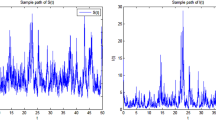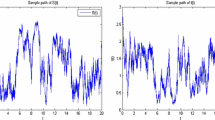Abstract
The susceptible-infected-recovered (SIR) model has been used extensively to model disease spread and other processes. Despite the widespread usage of this ordinary differential equation (ODE) based model which represents the mean-field approximation of the underlying stochastic SIR process on contact networks, only few rigorous approaches exist and these use complex semigroup and martingale techniques to prove that the expected fraction of the susceptible and infected nodes of the stochastic SIR process on a complete graph converges as the number of nodes increases to the solution of the mean-field ODE model. Extending the elementary proof of convergence for the SIS process introduced by Armbruster and Beck (IMA J Appl Math, doi:10.1093/imamat/hxw010, 2016) to the SIR process, we show convergence using only a system of three ODEs, simple probabilistic inequalities, and basic ODE theory. Our approach can also be generalized to many other types of compartmental models (e.g., susceptible-infected-recovered-susceptible (SIRS)) which are linear ODEs with the addition of quadratic terms for the number of new infections similar to the SI term in the SIR model.


Similar content being viewed by others
References
Anderson RM, May RM (1991) Infectious diseases of humans dynamics and control. Oxford University Press, Oxford
Andersson H, Britton T (2000) Stochastic epidemic models and their statistical analysis. Lecture Notes in Statistics, chapter 5. Springer, New York
Armbruster B, Beck E (2016) An elementary proof of convergence to the mean-field equations for an epidemic model. IMA J Appl Math. doi:10.1093/imamat/hxw010
Benaïm M, Le Boudec J-Y (2008) A class of mean-field interaction models for computer and communication systems. Perform Eval 65(11–12):823–838
Bortolussi L, Hillston J, Latella D, Massink M (2013) Continuous approximation of collective system behavior: a tutorial. Perform Eval 70(5):317–349
Cardelli L (2008) From processes to ODEs by chemistry. TCNature, International Federation for Information Processing, vol 273. Springer, Boston, pp 261–281
Daley D, Kendall D (1964) Epidemics and rumours. Nature 204(225):1118
Daley D, Kendall D (1965) Stochastic rumors. IMA 1(1):42–55
Decreusefond L, Dhersin J-S, Moyal P, Chi Tran V (2012) Large graph limit for an SIR process in random network with heterogeneous connectivity. Ann Appl Probab 22(2):541–575
Ethier SN, Kurtz TG (1986) Markov processes: characterization and convergence, chapter 11.2. Wiley series in probability and statistics. Wiley, Hoboken
Giraudo D (2014) Bound the variance of the product of two random varables. Mathematics Stack Exchange. http://math.stackexchange.com/q/1044864 (version: 2014-11-30)
Hale J (2009) Ordinary Differential equations, chapter 1.6. Dover Books on Mathematics Series. Dover Publications, Mineola
Keeling MJ (1999) The effects of local spatial structure on epidemiological invasions. Proc R Soc Lond B 266:859–867
Kephart J, White S (1993) Measuring and modeling computer virus prevalence. In: Proceedings, 1993 IEEE computer society symposium on research in security and privacy, pp 2–15
Kermack W, McKendrick A (1927) A contribution to the mathematical theory of epidemics. In: Proceedings of the royal society of London. series a: containing papers of a mathematical and physical character, vol. 115, No. 772, pp. 700–721
Kurtz TG (1970) Solutions of ordinary differential equations as limits of pure jump Markov processes. J Appl Probab 7:49–58
Kurtz TG (1971) Limit theorems for sequences of jump Markov processes approximating ordinary differential processes. J Appl Probab 8(2):344–356
May RM, Anderson RM (1983) Epidemiology and genetics in the coevolution of parasites and hosts. Proc R Soc Lond B Biol Sci 219(1216):281–313
Rand DA (1999) Correlation equations and pair approximations for spatial ecologies. CWI Q 12(3&4):329–368
Ross S (2007) Introduction to probability models, chapter 6.4, 9th edn. Academic Press, San Diego
Simon PL, Kiss IZ (2012) From exact stochastic to mean-field ODE models: a case study of three different approaches to prove convergence results. IMA J Appl Math 78(5):945–964
Volz E (2008) SIR dynamics in random networks with heterogeneous connectivity. J Math Biol 56(3):293–310
Acknowledgements
We thank Peter L. Simon, Tom Britton, and two anonymous referees for helpful comments.
Author information
Authors and Affiliations
Corresponding author
Appendix
Appendix
Lemma 4 Consider the initial value problems \(x'=f_1(t,x)\), \(x(0)=x_1\) and \(x'=f_2(t,x)\), \(x(0)=x_2\) with solutions \(\varphi _1(t)\) and \(\varphi _2(t)\) respectively. If \(f_1\) is Lipschitz in x with constant L and \(\left||f_1(t,x)-f_2(t,x)\right||\le M\), then \(\left||\varphi _1(t)-\varphi _2(t)\right||\le (\left||x_1-x_2\right||+M/L)e^{Lt}-M/L\).
Proof
Using the integral form of the differential equations,
Using the triangle inequality,
Using the integral form of the triangle inequality,
Applying the triangle inequality again,
Applying the assumptions of this lemma,
Applying a specialized form of Gronwall’s inequality then proves the claim.
Lemma 5
(Gronwall’s Inequality) Suppose for \(t\ge 0\), that \(\theta (t)\) is a continuous nonnegative function; \(L,M\ge 0\); and \(\theta (t)\le \theta (0)+\int _0^t (L\theta (u)+M) du\). Then for \(t\ge 0\), \(\theta \) is bounded by the solution to the initial value problem \(x'=Lx+M\), \(x(0)=\theta (0)\):
Proof
This result can be found in any graduate ODE text such as Lemma 6.2 in Hale (2009).
Rights and permissions
About this article
Cite this article
Armbruster, B., Beck, E. Elementary proof of convergence to the mean-field model for the SIR process. J. Math. Biol. 75, 327–339 (2017). https://doi.org/10.1007/s00285-016-1086-1
Received:
Revised:
Published:
Issue Date:
DOI: https://doi.org/10.1007/s00285-016-1086-1




